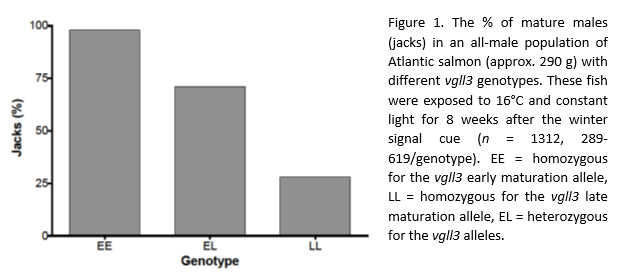VGLL3 IS ASSOCIATED WITH THE AGE OF PUBERTY IN FARMED ALL MALE ATLANTIC SALMON
Atlantic salmon (Salmo salar) display a large degree of phenotypic plasticity regarding the age at puberty and this has been linked to the vgll3 locus. In the current study, we aimed to establish the extent to which the vgll3 alleles explain the likelihood of male salmon to enter puberty following environmental regimes that stimulate parr (i.e. dwarf males) and/or post-smolt (i.e. jacks) maturation. Initially we established an all-male line of Atlantic salmon using sex reversal to produce YY males that were used to fertilize XX eggs. We then conducted two experiments. Firstly, two YY males heterozygous for vgll3 were crossed with four females, two of which were homozygous for the early vgll3 maturation genotype and two were homozygous for the late vgll3 maturation genotype. Fish were reared on a photoperiod and temperature regime known to induce post-smolt maturation. In the second experiment, one YY male heterozygous for vgll3 was crossed with three females heterozygous for vgll3. These fish were reared on a regime that induced both parr then post-smolt maturation. In both parr and post-smolts studies, males with the early vgll3 maturation genotype were significantly more likely to enter puberty as parr and/or post-smolts than those with the late maturation genotype, whereas those progeny heterozygous for vgll3 were intermediate between the early and late genotypes. In addition, we also found some phenotypic females within our all male line (40/1384), of which 5% were genetically male.
